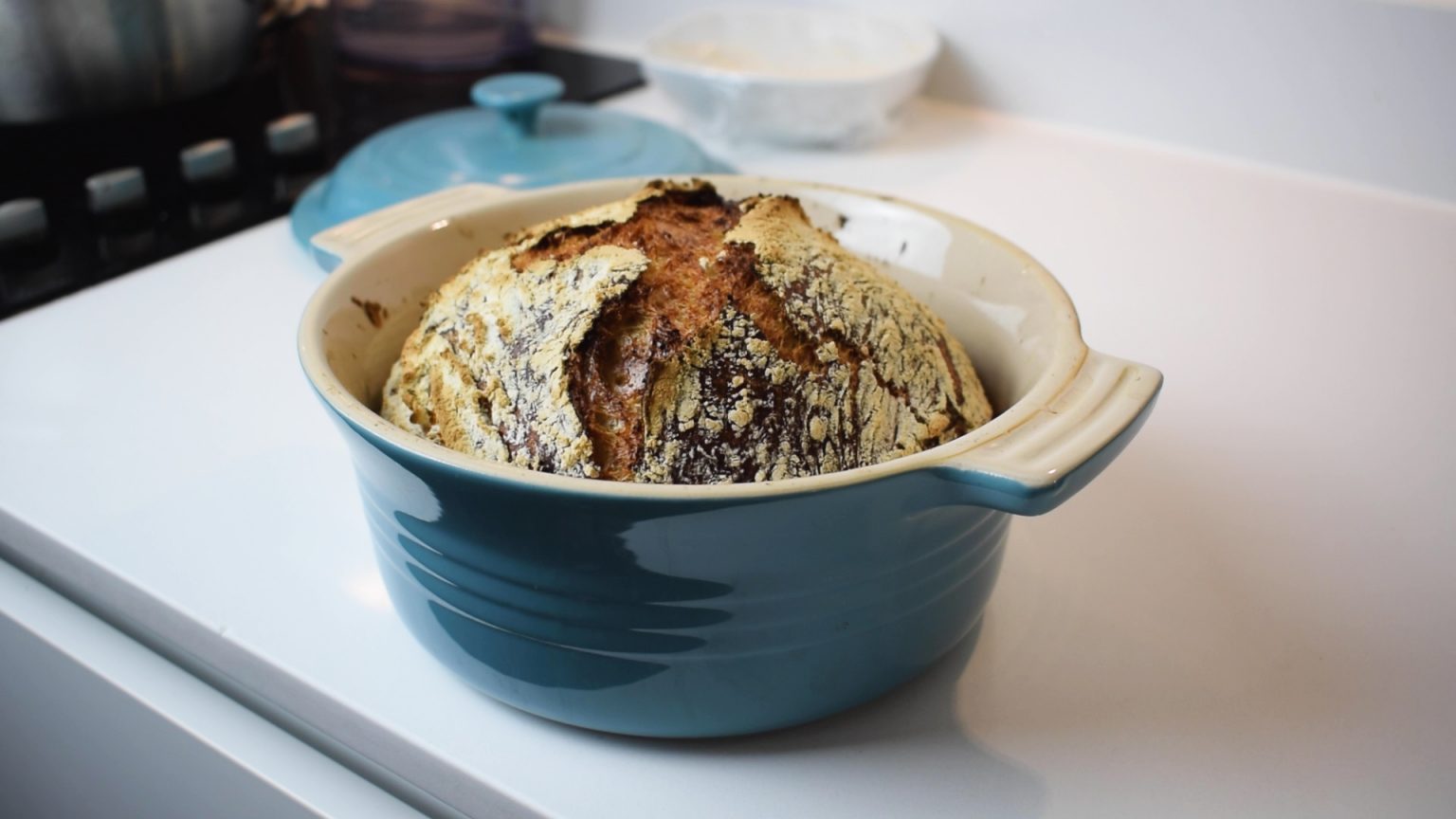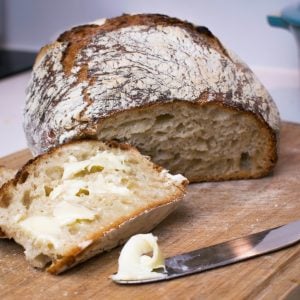The easiest no knead bread that tastes just like sourdough bread. This bread requires minimal effort, has a rustic crunchy crust and light interior.

Sourdough-like bread with minimal effort
Baking bread is probably one of the most satisfying processes in the baking world. From the simplest ingredients you get an end product that everyone loves and is absolutely delicious. Most people fear making bread because the sourdough process has a reputation for being difficult to master; those perfect glutenous holes in the bread, coupled with the crunchy crust are quite tricky to achieve.
This no knead bread is super simple and requires minimum effort. The result, however, is an unbelievably crunchy rustic bread, with the perfect taste.
Since developing this recipe, I have started making bread at home twice per week, and it only takes me minutes to prepare. There is some waiting to be done, but if you remember to prep your dough the night before, the next day you will get perfectly baked bread.
The recipe is based on the most common ingredients found in everyone's cupboard: flour, yeast and salt.

A very forgiving recipe
The best thing about this no knead bread is that it doesn't need you to be extremely accurate. Don't have a scale? No problem. You can use regular tea mugs.
Timing is quite flexible as well. The proving time can vary, and the quality of the bread won't be compromised. As long as you let your bread prove between 4 and 12 hours, your bread will come out perfectly. The only part of the timing that needs to be quite exact is the baking itself.
Being no-knead, the recipe also avoids the dangers of over-kneading or creating a dense bread by mistake. It really is the simplest bread recipe!
An important step: folding the dough
As the name suggests, this no knead bread requires no kneading. However, you will need to do some quick folding of your dough once it's proved for a few hours. The folding couldn't be simpler: with a spatula or a scraper take the sides of the bread and fold the over on themselves like the quick video below.
By folding the dough on itself the aim is to help release more gluten, and make the bread more airy inside. What we are looking for is a supple dough, that becomes smoother the more you fold it in.
Ingredient round-up
I started baking bread whilst being on lockdown during the Coronavirus pandemic. As everyone knows, ingredients were in short supply, which made me want to make the recipe accessible to everyone.
The ingredients can easily be replaced:
- Strong white bread flour - this can be replaced with wholewheat or rye flour. Certain adjustments will have to be made, as different flours soak up water differently. Wholewheat needs more water, and typically an extra 50-100ml will do the trick. You can do it all by eye, and look for a sticky recipe, that's not dry or too liquid. Cake flour, although it can still make decent flour, is a bit too soft to create the crusty, tasty bread we all know and love.
- Fast-action dry yeast - the recipe can be adjusted to accommodate fresh yeast as well. The ratio will be 7g instant yeast to 30g fresh yeast. You can also use this recipe with sourdough starter, although the proving time will have to increase slightly. I recommend 24 hours proving in the fridge.
- Salt - I wouldn't recommend removing salt, as it helps improve the taste significantly. If you're on a low salt diet, removing the salt will not impact the quality of your bread.
- Sugar - although not essential to the recipe, I find it helps balance out the taste, as well as make the yeast a bit more active.
Adding extra ingredients
Besides being fail-proof, the recipe also allows for experimentation. You can add seeds, condiments, nuts and whatever else you'd like to taste in your bread. I recommend adding cardamom or Palestinian Za'atar for a beautiful flavour.
Running out of yeast? Remember this trick
Yeast seems to be in short supply nowadays, so if you're running low on either fresh or dry yeast, I have the perfect and simple solution.
- Once your bread dough has proved for some time, remove a small piece of dough and set it aside. The piece needs to be roughly a teaspoon in size.
- Place the dough scrap in a small bowl, and add 2-3 teaspoon of flour and a splash of water
- Mix until you get a runny paste
- Cover with cling film and store at room temperature if using the next day or in the fridge to be used within 4-5 days.

If you enjoyed this recipe, you will love these too:
If you’ve tried this recipe out, please don’t forget to rate and comment on this recipe. I love hearing from you, so feel free to reach out to me on social media as well and tag me in your posts!
Recipe

No Knead Bread (Easy Rustic Bread)
Equipment
- Dutch oven or pyrex dish with lid
Ingredients
- 500 g strong white bread flour (4 cups)
- 7 g salt (1 tsp)
- 7 g sugar (1 tsp)
- 4 g fast action yeast (½ tsp)
- 350 g water (1 ½ cups)
Instructions
- In a small bowl, add around 50g (¼ cup) of tepid water and sprinkle the yeast on top. Let soak for 5 minutes until the yeast starts bubbling.
- In a large bowl, add the bread flour, salt and sugar. Mix it well to combine. Add the water and bloomed yeast.
- Using the handle of a wooden spoon or any spatula, mix the flour and water until it just about combines. It will be very sticky, but try to resist the temptation to add more flour.
- Cover the bowl with cling film, and place a tea towel over it. Place in a warm place or inside the oven. Let the dough rest overnight (minimum 6-10 hours).
- The next day, preheat the oven to 240°C (460°F) fan assisted. Place a Dutch Oven, or Pyrex dish (with a lid) inside to get sizzling hot.
- Start folding the dough in on itself with a scraper or spatula. Scoop the scraper under the dough, then stretch it over the top. Repeat this approximately 10 minutes until the dough becomes smooth and less sticky.
- Once the pot is sizzling hot hot, carefully remove from the oven and sprinkle some flour on the bottom. Sprinkle a little more flour over the dough, then place it in the hot pot.
- Cover with lid and bake for 30 minutes. Afterwards, remove the lid and bake for an extra 20 minutes until your bread is a lovely light brown colour.
- Let the bread cool down completely on a wire rack before cutting.
Video

Notes
- I recommend using a kitchen scale in grams for more accuracy. The cups used for the conversion are standard US customary cups (1 cup flour = 136g). There are many different types of cups across the globe, which is why I strongly recommend using grams instead.
- This recipe calls for strong white bread flour, as plain white flour will not yield the same results. Strong white flour needs to have at least 12-14% protein, (12-14g per 100g of flour). This type of flour has more gluten, which makes for a better bread texture.
- Calories are indicative only, and are estimated per slice (1 loaf = 12 slices).



Leave a Reply